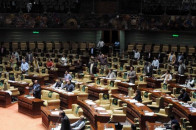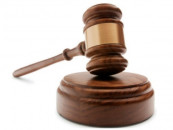With its new gadgets, police can even trace deleted data from phones
Lab has also maintained archives of digital images and bullet shells.

With its new gadgets, police can even trace deleted data from phones
The Digital Forensics Science Laboratory at the Sindh Police forensics division obtained two devices, the CellXtract-TNT and the UFED Touch Ultimate, which will help gain information on a suspect’s cell phone or computer. These machines will also help the police decipher and download the data from a SIM or phone set used in any crime.
“Cell phones are commonly being used in bomb blasts but the problem is that the explosion destroys the SIM and the phone, which means that investigators lose important clues,” forensic division chief AIG Munir Sheikh told The Express Tribune at the lab’s inauguration ceremony at the Garden Headquarters on Wednesday. “This will not happen anymore as we can retrieve any data from a piece of a phone set or a SIM, even if it has been deleted.”
The forensics lab has four basic units - fingerprints, vehicle examination, ballistics/firearms and questionable documents. Referring to the Integrated Ballistic Identification System (IBIS), AIG Sheikh said that the lab has already collected the details of over 6,000 empty shells used in criminal cases in Karachi. “Before we used to check individual archives if we wanted to find out if the bullet shell has been used in a previous incident,” he said, adding that it was a very lengthy process. “Now, with the IBIS, we can get the 10 closest matches within seconds.”
The Crime Scene Unit has attended a total of 533 crime scenes and collected data from 71 murders, 242 dacoities, 105 burglaries/robberies, 34 vehicles involved in murder cases, 51 unidentified bodies and 30 cases of different offences, such as bomb blasts, snatchings and road robberies. The lab has also maintained an archive of digital images, which include 5,970 images of firearms particularly those used in target killings, 4,435 digital photographs of engine and chassis numbers of vehicles and over a thousand footages of crime scenes.
“We have also established a Public Facilitation Desk to help not only the investigating officers but also the general public,” he said. People will be given assistance in areas, such as fingerprints for immigration, online verification of CNICs, which is free of cost, and computerised facial sketching of suspects, he explained. “We will be able to deliver in a yet better manner. It is undoubtedly a remarkable occasion for the Sindh Police.”
The first forensic science laboratory in Karachi was established in 1958 at the Central Police Office. Later, the Criminalistics Division was created by merging the Fingerprint Bureau, established before partition, with the Florence Science Laboratory in 1983. Finally the Criminalistics Division was renamed ‘Forensic Division’ in 2009.
Appreciating the importance of forensic science in the criminal justice system, Inspector General of Police Fayyaz Leghari said that, “we would not stop here since it is only the beginning.” “We plan to move ahead to goals, such as separate labs for questionable documents, a crime scene unit, systems for vehicle identification and tool marks identification, IBIS, accreditation, an online library and set up a DNA laboratory for Sindh Police.”
An Australian Federal Police representative, Julian Slater, said that terrorism, murders, burglaries, sexual assaults, and thefts have all been prosecuted on the basis of forensic evidence found at the scene, on victims or on defendants. He added that it goes without saying that forensic science makes an enormous contribution to the safety of community and country.
Published in The Express Tribune, November 15th, 2012.



















COMMENTS
Comments are moderated and generally will be posted if they are on-topic and not abusive.
For more information, please see our Comments FAQ